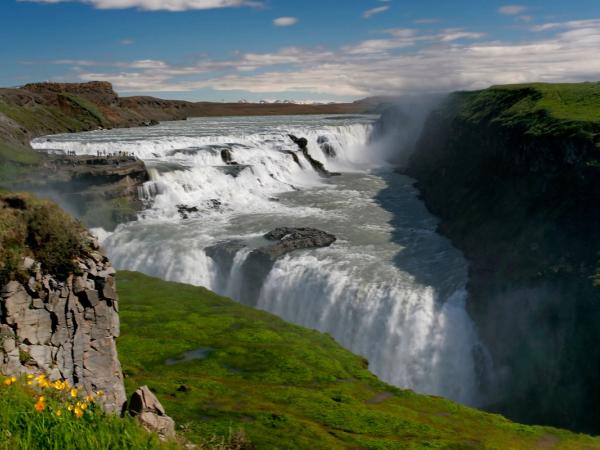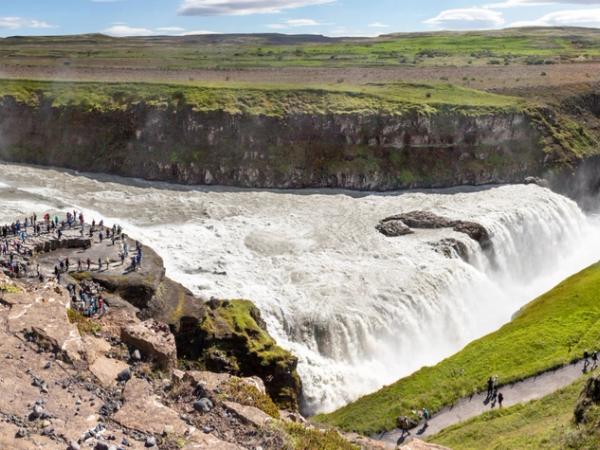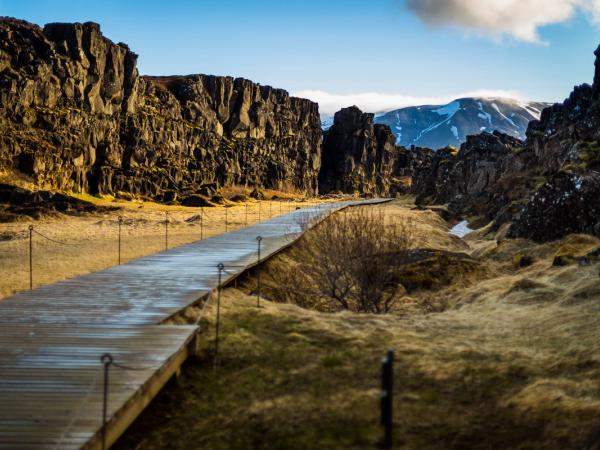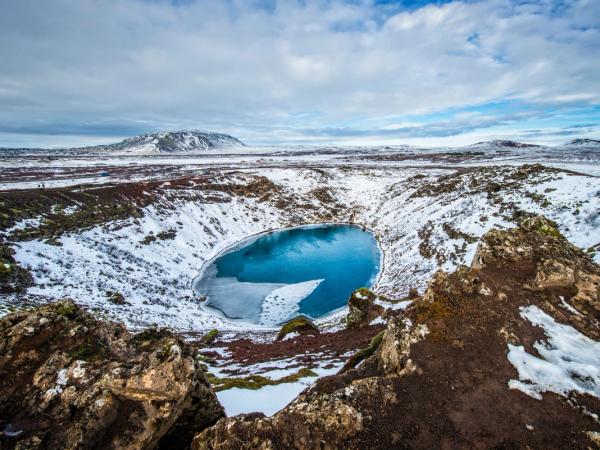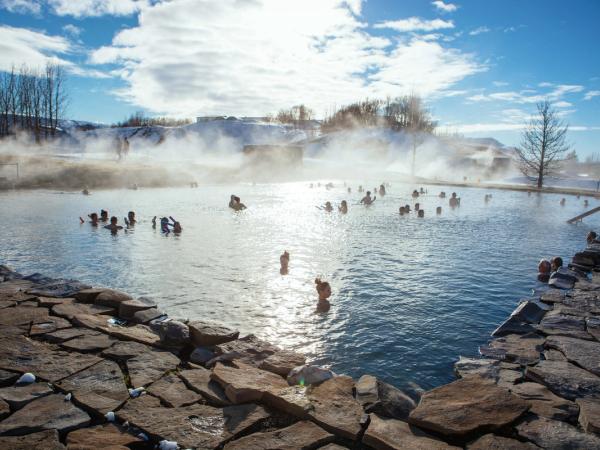
Discovering Gullfoss, The "Golden Waterfall" of Iceland
Iceland is a land of stunning natural beauty, with its landscapes marked by dramatic waterfalls, geysers, and volcanic craters. Among its many breathtaking sites, Gullfoss stands out as one of the most captivating. Known as the "Golden Waterfall," Gullfoss is a must-see destination for anyone traveling to Iceland.
Key Takeaways
- Gullfoss, the "Golden Waterfall," features a stunning two-tiered cascade that plunges 32 meters
- The waterfall is an essential stop on Iceland's Golden Circle route, which also includes Þingvellir National Park and the Geysir geothermal area
- Nearby attractions include Þingvellir, Geysir, Kerið Crater, the Hvítá River, the Secret Lagoon, and Friðheimar Tomato Farm
Why is Gullfoss Worth a Visit?
Gullfoss, known as the "Golden Waterfall," is one of Iceland's most famous waterfalls (and natural wonders), drawing visitors from around the world. This stunning waterfall, located on the Hvítá River, features a dramatic two-tiered drop that falls 32 meters (105 feet) into a rugged canyon. The powerful rush of water creates a mist that often forms beautiful rainbows on sunny days.
But Gullfoss is more than just a pretty sight. It also stands for Iceland's commitment to protecting nature. In the early 20th century, a woman named Sigríður Tómasdóttir fought to save the waterfall from being turned into a hydroelectric plant. Her efforts showed how much Icelanders care about their natural heritage. Visiting Gullfoss is not just about seeing a beautiful waterfall; it's also about connecting with a story of conservation and Icelandic culture.
Recently released data from the Icelandic government revealed that Gullfoss (west side) was the most-visited spot in Iceland in 2024, with 1,575,152 visitors. That must be for a reason!
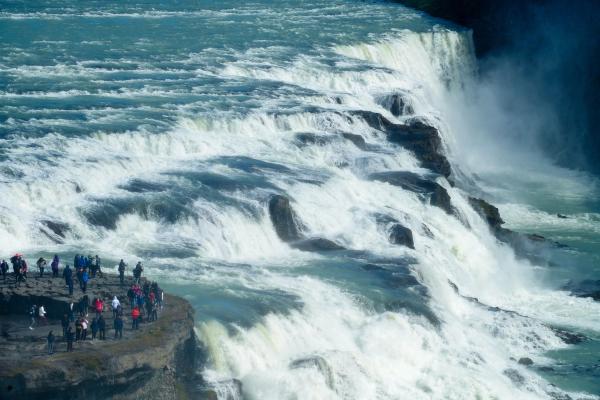
Gullfoss Facts & Features
Gullfoss, one of Iceland's most beloved natural attractions, boasts a range of fascinating facts and features that enhance its appeal to visitors. Here's a deeper look into what makes Gullfoss so special:
Height and Structure
- Total Height: Gullfoss plunges a total of 32 meters (105 feet) in a two-stage drop.
- First Drop: The first cascade is 11 meters (36 feet) high.
- Second Drop: The second, more dramatic plunge is 21 meters (69 feet), creating a powerful and awe-inspiring sight as the water crashes into the canyon below.
Name Meaning and Cultural Significance
- Golden Falls: The name "Gullfoss" translates to "Golden Falls" in Icelandic. This name is inspired by the golden hue that often appears in the glacial water under sunlight, creating a stunning visual effect that enchants onlookers.
- Local Legends: According to local folklore, the name might also be linked to a story about a wealthy farmer who, unwilling to see his gold fall into the wrong hands, threw his treasure into the waterfall.
Formation and Geology
- Ice Age Origins: Gullfoss was formed during the last ice age, carved out by the relentless force of glacial meltwater from the Langjökull glacier. The Hvítá River, fed by this glacier, continues to shape the landscape.
- Canyon Creation: The waterfall flows into a deep, narrow canyon that stretches approximately 2.5 kilometers (1.6 miles) long and up to 70 meters (230 feet) deep. This dramatic geological feature adds to the waterfall's impressive nature.
Flow Rate and Seasonal Changes
- Summer Flow Rate: In the summer months, the flow rate of Gullfoss can reach about 140 cubic meters per second, showcasing its full, thunderous power.
- Winter Flow Rate: During the winter, the flow rate decreases to around 80 cubic meters per second, but the waterfall remains a spectacular sight, often surrounded by ice and snow that enhance its beauty.
Environmental Protection
Gullfoss's preservation is largely attributed to Sigríður Tómasdóttir, the daughter of a local farmer. In the early 20th century, she fought tirelessly to protect the waterfall from industrial exploitation, even threatening to throw herself into the falls in protest. Her efforts were successful, and today, Gullfoss is a protected natural site.
Visitor Experience
- Viewing Platforms: Several well-maintained viewing platforms and trails allow visitors to experience Gullfoss from various angles. These platforms provide breathtaking views and photo opportunities, capturing the falls' grandeur.
- Seasonal Views: Each season offers a unique perspective of Gullfoss. In summer, the waterfall is surrounded by lush greenery, while in winter, it is often encased in sparkling ice, offering a magical and serene landscape.
Educational Insights
Informative signs and displays near the waterfall provide educational insights into its geology, history, and environmental significance, enriching the visitor experience.
Conservation Efforts
Gullfoss is part of a protected nature reserve, ensuring its pristine condition and natural beauty are preserved for future generations to enjoy.
Whether you're drawn to Gullfoss for its majestic beauty, its geological significance, or its inspiring story of conservation, this waterfall offers a profound connection to Iceland's natural and cultural heritage.
Where’s Gullfoss and How to Get There
Gullfoss is located in the canyon of the Hvítá River in southwest Iceland, about 113 kilometers (70 miles) from Reykjavík. It's a key stop on the Golden Circle route, a popular tourist circuit that also includes Þingvellir National Park and the Geysir geothermal area.
By Car:
Driving from Reykjavík to Gullfoss is straightforward and takes about two hours. Here's the route as per Google Maps:
1. Garðastræti and Suðurgata to Hringbraut/Route 49:
- Start by taking Garðastræti and Suðurgata
- Drive for approximately 1.2 kilometers (5 minutes) to reach Hringbraut/Route 49
2. Route 49 to Vesturlandsvegur/Þjóðvegur 1 (Ring Road):
- Follow Route 49 and merge onto Vesturlandsvegur/Þjóðvegur 1, also known as the Ring Road
- Continue on Þjóðvegur 1 for about 58 minutes (62.1 kilometers) until you reach Þingvallavegur/Route 36
3. Þingvallavegur/Route 36 to Gjábakkavegur/Route 365:
- Follow Þingvallavegur (Route 36) towards Þingvellir National Park
- Continue straight onto Gjábakkavegur/Route 365 and follow it for 14.3 kilometers (11 minutes)
4. Route 365 to Route 37:
- Continue on Route 365 until it merges with Laugarvatnsvegur/Route 37
- Follow Route 37 for about 33 minutes (38.3 kilometers) until you see signs for Gullfoss Parking
5. Final Destination:
- Turn right into the Gullfoss Parking area
The roads are well-maintained and clearly marked, making the drive straightforward. However, always check weather conditions, especially in winter, as the roads can become icy.
What to Wear When Visiting Gullfoss
Iceland's weather can be unpredictable, so it's essential to dress appropriately for a visit to Gullfoss:
- Layers: Wear multiple layers to adjust to changing temperatures. A base layer for warmth, a middle layer for insulation, and a waterproof and windproof outer layer are recommended.
- Footwear: Sturdy, waterproof hiking boots are a must, especially if you plan to walk the trails around the waterfall.
- Winter Gear: In colder months, additional thermal wear, gloves, a hat, and crampons for icy conditions will keep you comfortable and safe.

Surrounding Sites & Things to Do at Gullfoss
Gullfoss is part of the Golden Circle, which offers numerous other attractions and activities:
- Þingvellir National Park: A UNESCO World Heritage Site, Þingvellir is where you can walk (and dive) between the North American and Eurasian tectonic plates. It's also the historic site of Iceland's first parliament.
- Geysir Geothermal Area: Home to Strokkur, a geyser that erupts every few minutes, shooting hot water up to 30 meters (100 feet) into the air.
- Hvítá River: Popular for rafting and kayaking, offering adventurous activities downstream from Gullfoss.
- Kerið Crater: A volcanic crater lake with striking red and orange rocks that contrast beautifully with the blue water, making it a popular spot for photography.
- Secret Lagoon: Located in the village of Flúðir, this geothermal pool is a lesser-known alternative to the Blue Lagoon. It offers a relaxing soak in naturally warm waters surrounded by nature.
- Friðheimar Tomato Farm: A unique greenhouse restaurant where you can enjoy fresh tomato-based dishes and learn about sustainable farming in Iceland. The farm also features an exhibit on Icelandic horses.
Experience Gullfoss Power
Visiting Gullfoss is an amazing experience. The waterfall's powerful, two-tiered cascade and mist create a stunning view, especially when sunlight makes the water glow golden. Including Gullfoss in your Golden Circle tour is a must for anyone wanting to experience Iceland's breathtaking beauty.

